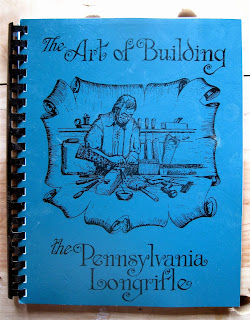The Art of Building the Pennsylvania Longrifle-A New Project?
Ax and rifle-these subdued the American wilderness in the hands of the early woodsmen.
Bernard S. Mason, Camping Crafts, 1973
The Art of Building the Pennsylvania Longrifle by Dixon, Ehrig and Miller, is a wonderful book that has been spending too much time on my workbench these last few weeks every since it arrived in the mail from the Shurlock Publishing Company. Not that I want to build a Pennsylvania long rifle, I'd rather build a Tennessee or Southern "poor boy" rifle, but my wife has been asking me if we should start going to mountain man rendezvous events. I did living history for the National Park Service for a long time and Amanda can do any kind of beading there is, so it is logical for us to create personas head out to some "rondyvous" for a raring good time.
What does this have to do with long rifles? I plan on buying a Lyman Great Plains rifle kit from Lyman Products so I can "make" my own plains rifle to use at rendezvous shoots and to elk hunt with. Not to go too far into mountain man geek-land, the Lyman Great Plains rifle is basically a copy of a half stock Hawken's rifle similar to the kind Kit Carson and Jim Bridger used towards the end of their careers. The factory Lyman Great Plains Rifle is "accepted" at most primitive shoots, and me, being a history geek, I want to customize this kit with a full stock, basically turning the rifle into a full-stock Hawken's, or with a little more tweaking, make it look like Leman trade rifle. (If you want to know the difference between these rifles, just Google it!) I thought getting a copy of Mr. Dixon's book would help me immensely when I get the time make this rifle.
The Art of Building the Pennsylvania Longrifle is, as I mentioned earlier, a wonderful book, written very simply and Mr. Dixon easily takes you from how to inlay the barrel to the stock, fit the lock to the stock, carve acanthus leaves on the stock, brown the barrel and end up with a gorgeous rifle. The thing I like about this book is Mr. Dixon quickly tells you that this is something that anyone can do. He never says "now, this next part is tricky" a statement that often appears in how-to-books, oh, such as some books on making classical guitars. Not this book, Mr. Dixon urges you to get up and do it and if you make a mistake just fix it! Then he tells you how to fix the most common mistakes! You gotta love that!
Give the book a perusal, it is worth it just to read through the inlaying procedures, I learned a few new things.
Remember, keep yer powder dry and an eye on yer topknot!
Bernard S. Mason, Camping Crafts, 1973
The Art of Building the Pennsylvania Longrifle by Dixon, Ehrig and Miller, is a wonderful book that has been spending too much time on my workbench these last few weeks every since it arrived in the mail from the Shurlock Publishing Company. Not that I want to build a Pennsylvania long rifle, I'd rather build a Tennessee or Southern "poor boy" rifle, but my wife has been asking me if we should start going to mountain man rendezvous events. I did living history for the National Park Service for a long time and Amanda can do any kind of beading there is, so it is logical for us to create personas head out to some "rondyvous" for a raring good time.
What does this have to do with long rifles? I plan on buying a Lyman Great Plains rifle kit from Lyman Products so I can "make" my own plains rifle to use at rendezvous shoots and to elk hunt with. Not to go too far into mountain man geek-land, the Lyman Great Plains rifle is basically a copy of a half stock Hawken's rifle similar to the kind Kit Carson and Jim Bridger used towards the end of their careers. The factory Lyman Great Plains Rifle is "accepted" at most primitive shoots, and me, being a history geek, I want to customize this kit with a full stock, basically turning the rifle into a full-stock Hawken's, or with a little more tweaking, make it look like Leman trade rifle. (If you want to know the difference between these rifles, just Google it!) I thought getting a copy of Mr. Dixon's book would help me immensely when I get the time make this rifle.
The Art of Building the Pennsylvania Longrifle is, as I mentioned earlier, a wonderful book, written very simply and Mr. Dixon easily takes you from how to inlay the barrel to the stock, fit the lock to the stock, carve acanthus leaves on the stock, brown the barrel and end up with a gorgeous rifle. The thing I like about this book is Mr. Dixon quickly tells you that this is something that anyone can do. He never says "now, this next part is tricky" a statement that often appears in how-to-books, oh, such as some books on making classical guitars. Not this book, Mr. Dixon urges you to get up and do it and if you make a mistake just fix it! Then he tells you how to fix the most common mistakes! You gotta love that!
Give the book a perusal, it is worth it just to read through the inlaying procedures, I learned a few new things.
Remember, keep yer powder dry and an eye on yer topknot!



Comments
Post a Comment